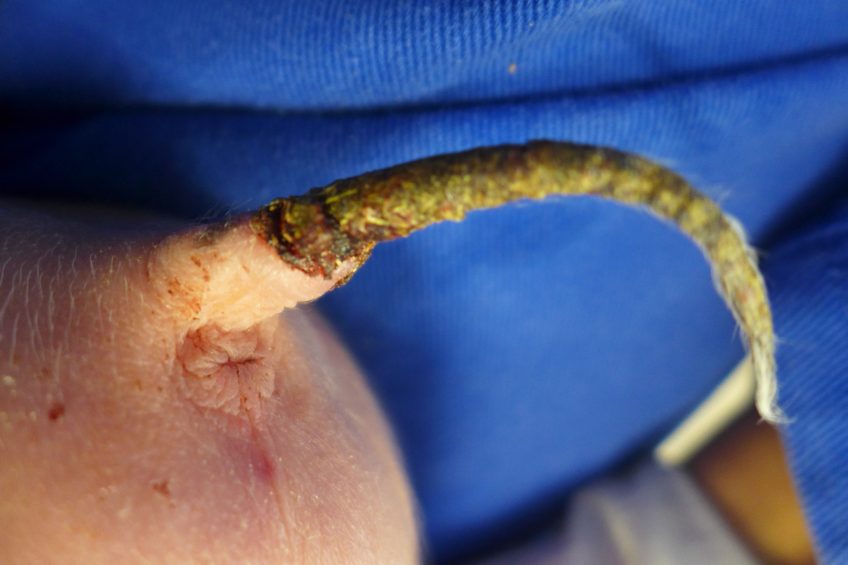Tail necrosis: A cause of tail biting?

Damaged tails are usually seen as an effect of tail biting caused by attacks by other pigs. But it looks like necrosis – inflammation and scabbing on pig tails, ears and claws – could be an even more important cause of tail biting. In order to solve the enigma of tail biting the question therefore is: what causes the necrosis?
Swine Inflammation and Necrosis Syndrome (SINS) is yet another influence factor associated with tail biting. Housing and management aspects including pen layout, stocking density, ventilation, feed and water supply and enrichment materials – from straw right through to chewing chains – have all been studied, and are still the focus of worldwide research. This research includes the ongoing work under the FareWellDock programme as described in recent issues of Pig Progress.
FareWellDock protocols emphasise the crucial importance of alert stock surveillance and quality management, not only for early identification of aggression and biting problems but also towards ensuring the required quality of ventilation, feed, herd health and hygiene.
Necrotic tissue
All these aspects of good management and hygiene also substantially influence the development of SINS in the pig barn. Recent experience in Germany has shown, for example, that the appearance of necrotic tissue on ears and tails of growers can lead to serious tail biting outbreaks, but can be corrected by adjusting protein and fibre content in the grower and feeder rations.
Behind the identification and description of the SINS inflammation and necrosis syndrome is research by professor Gerald Reiner and his team. Prof Reiner is head of the Department of Veterinary Clinical Sciences, at the University of Giessen, Hessen, Germany. Team member Mirjam Lechner from the Independent Pig Production Society (UEG), in Hohenlohe, Germany, explains: “Already well established is the acceptance that the causes behind tail biting are highly complex and the appearance of bitten tails in any particular herd often hard to predict. It is extremely important to recognise that tail biting is not a singular symptom.”
Importance of inflammation
The team’s work with SINS identifies the importance of inflammation and necrosis development, not only in ear and tail tissue, but also in piglet claws (laminitis). These combined aspects of the syndrome are important indicators of deficient management, housing and feeding and usually mean that tail biting outbreaks are up ahead.
Just to explain the background a little more, let’s take a look at the different types of biting in the pig pen. These can be divided into primary tail biting and tail biting because of necrosis. Primary biting takes place where the previously undamaged tail is injured by aggressive or frustrated pen mates. The frustration is thought to be largely caused by management errors, e.g. overcrowding in the pens or at feed troughs, or not enough enrichment materials. Tail biting because of the presence of necrosis is maybe even more prevalent than primary tail biting. It is a problem right through the production cycle because necrosis symptoms can also be seen with weaners and feeders. The symptoms – also observable in wild pigs – start with swelling, reddening and exudation on the tail, sometimes with demarcation and tail tip loss.
But usually biters are encouraged at this stage. Mirjam Lechner: “As seen with other pig afflictions such as rectum prolapse, other pigs are attracted by the injured tissue and start nibbling and biting. The attraction comes from the smell of the tissue and the appearance of blood.”

Now, this is where SINS comes into the story as a systemic metabolism problem. The University of Giessen team calculates that the metabolic processes leading to the formation of necrotic tissue involve irritation and itchiness in the afflicted areas, such as the tail. “This could be why a pig does not move away from the nibbling action which may actually represent a relief for the victim,” explains Ms Lechner. “If this behaviour continues, injuries occur, blood and serum are produced and caudophagia (tail biting and eating of tissue) is the next step.”
The necrosis also leads to other, not yet fully quantified, tail injury aspects that lead to tissue damage and loss without biting, although secondary injuries and infection can also take place from subsequent biting attacks when blood and serum are present.
Evaluating necrosis
The Giessen University researchers developed a scoring system for evaluating necrosis and inflammation degree on tails, ears, etc. and applied this to 44 weaners kept under standardised conditions with no biting having taken place, and no mechanical damage to tissue from contact with flooring or pen equipment. While applying the scoring system, the team found necrotic scabs on the tail tips of between 40 to 50% of the piglets. Also noted were symptoms on the pig feet: swelling, bleeding and cracks on heels and soles.
So the next question may well be: What is behind the appearance of this primary necrosis, inflammation and laminitis with very young pigs? “The causes are not yet fully known,” admits Ms Lechner. She goes on to point out that new data from cattle indicate that tail tip necrosis is highly correlated to rumen acidosis and laminitis.
With all affected animals, it has been seen that symptoms of necrosis and oedema (abnormal accumulation of fluid in tissue) in pigs are accompanied by centralisation of the circulation, restricting blood flow to capillary systems in the body extremities, e.g. ears, tail and feet. Research by the Universities of Vienna and Munich also indicates associated increased production of microbial degradation by-products such as lipopolysaccharides (LPS). The degradation by-products are recognised in the pig blood circulation by defence cells such as macrophages, leading to production of inflammation mediators. A number of physical changes occur in the affected locality as the body prepares a defence against the assumed pathogen invasion. The slow-down of blood supply as mentioned above restricts oxygen supply to peripheral tissues. These become painful and irritated and finally necrotic. The blood vessels in the tail, ears and claw corium are especially susceptible to this development.
Degradation by-products
Where do these microbial degradation by-products come from? Investigations over several decades indicate that they originate mainly from the intestine, their increase caused by poorly balanced rations (e.g. too much protein, not enough crude fibre), resulting in slower peristalsis, decreased intestinal acidity, multiplication of gram negative pathogens. These processes are aided by reduced water intake by the animals through poor supply (from faulty nipple drinkers, for instance) – also by high pathogen burdens in the drinking water itself, as well as heat stress for instance, or by mycotoxins in feed.
High stocking densities that help reduce antibody levels in pigs, affecting colostrum and milk production of sows, can further increase the problem. Piglets also ingest endotoxins from sows’ milk and this has also been found by researchers to be responsible for inflammation and necrosis on piglet ears and tails.
Endotoxin prevalence also tends to depress liver and kidney functions. One effect of this is that blood clotting efficiency is reduced which in turn encourages more bleeding from necrotic areas, and therefore possibly increased biting.
Correctly balanced rations
All findings so far by the University of Giessen research underline the importance of correctly balanced rations in reducing the SINS problem and subsequent tail biting. A good supply of drinking water for the growing and finishing pigs is critical in this respect. One last very important point: inflammation and necrosis – as well as direct tail biting attacks – are definitely reduced when a good balance of crude fibre is in the diet and additional roughage in the form of forage, straw or straw pellets is made available.












